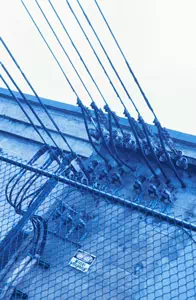Air Permitting
This page provides information on equipment and materials for which healthcare facilities may be required to obtain air quality permits:
-
Background information:
- Equipment:
-
Materials:
See the HERC Clean Air Act page for additional information on the federal law that authorizes the EPA to impose air quality permit requirements.
Sources of air emissions at healthcare facilities
At healthcare facilities, air emissions can come from numerous sources, including:
-
boilers
-
medical waste incinerators
-
air conditioning and refrigeration units
-
crematoria
-
asbestos
-
paint booths
-
ethylene oxide sterilization units
-
emergency generators
-
anesthesia
-
laboratory chemicals
-
laboratory fume hoods
Permits that may
be required under the
Federal Clean Air Act
Title I: Some large pieces of equipment may be subject to New Source Performance Standards (NSPSs) under the Clean Air Act. Information on NSPS requirements for certain specific pieces of equipment can be found on HERC pages dealing with
Many types of emission involving Hazardous Air Pollutants (HAPs) are also regulated under Title I. Specific cases are discussed in more detail in the next section.
Title V: This section of the CAA requires that all “major sources” (and certain minor sources) obtain an overall operating permit. A healthcare facility that qualifies as a major source would be required to have a Title V permit, and may be required to submit a permit application that includes information about emissions, control devices, and the general process at the facility. Permits may limit pollutant emissions and impose monitoring, recordkeeping, and reporting requirements.
Monitoring requirements for many facilities with Title V permits are specified in the Compliance Assurance Monitoring (CAM) regulations. For facilities that meet emissions requirements on their permits by using pollution control equipment, CAM may require that the facilities monitor the control equipment to assure that it is operated and maintained as prescribed in their permits.
NESHAPs that may apply to healthcare facilities
Industrial, Commercial and Institutional Boilers and Process Heaters
This NESHAP may apply at hospitals that are major hazardous air pollutant emitters under the CAA. A major emitter is defined as emitting at least:
-
10 tons/year of a single HAP, or
-
25 tons/year of a combination of HAPs
Note: Only healthcare facilities that are part of a large entity such as a prison, university or military base are likely to be major sources under the CAA. The EPA website provides a page with additional information about rules pertaining to boilers.
More information on the boiler NESHAP can be found on the HERC Boilers page.
Medical Waste Incinerators
Regulations: See Combustion Portal.
Under the CAA, EPA regulates air emissions from hospital medical/infectious waste incinerators (HMIWI). When burned, medical waste may emit air pollutants, including:
-
acid gases, such as
-
hydrochloric acid (HCl)
-
dioxins
-
furans
-
-
metals, such as
-
lead (Pb)
-
cadmium (Cd)
-
mercury (Hg)
-
EPA has developed emission standards that apply both to incinerators used by hospitals and healthcare facilities as well as to those used by commercial waste treatment and disposal companies to treat medical waste.
The emission guidelines are intended to meet the requirements of the federal CAA. States can establish their own standards, but they must be at least as protectiveas the federal standards. These standards will result in reductions in the air emissions of concern from HMIWI.
The EPA provides an index page with links to detailed information on the HMIWI rule.
Generators (Stationary Reciprocating Internal Combustion Engines)
Stationary reciprocating internal combustion engines (usually gas or diesel generators) at healthcare facilities are probably subject to this standard if:
-
they are part of a facility that is major source for HAP (i.e. that has the potential to emit at least:
-
10 tons/year of a single HAP, or
-
25 tons/year of a combination of HAPs
-
-
they are over 500 horsepower, and
-
they were built after December 19, 2002
Note: Only healthcare facilities that are part of a large entity such as a prison, university or military base are likely to be major sources under the CAA. The full set of applicability criteria for various cases is somewhat elaborate. The EPA website provides an applicability flowchart covering a range of situations.
Asbestos
A healthcare facility that performs demolition and renovation operations will be subject to the CAA NESHAP for asbestos. Here is a brief summary of requirements; please refer to the additional resources listed below for more details:
-
A written notice of intention to demolish or renovate must be submitted to EPA at least 10 working days prior to the start of construction.
-
No asbestos is to be stripped, removed, or otherwise handled or disturbed unless at least one authorized representative trained in NESHAP asbestos regulations is present.
-
Asbestos must be removed prior to demolition or renovation and proper precautions must be made such as wetting down the material to keep it intact.
Additional resources for asbestos:
-
The Asbestos Informer gives a concise explanation of the risks posed by asbestos and applicable regulations.
-
EPA Asbestos Ombudsman:
-
Hours of Service: 8:30 a.m. - 5:00 p.m. (EST) M - F
-
Telephone: 800-368-5888 (available 24 hours a day)
-
-
Managing Asbestos in Place: A Building Owner's Guide to Operations and Maintenance Programs ("Green Book", available in paper copies only) can be ordered through the Ombudsman.
Ethylene oxide (EtO)
Some healthcare facilities use ethylene oxide as a sterilant for certain types of healthcare supplies and devices. In some cases, manufacturers recommend this practice to ensure the sterility of a product.
On December 28, 2007 the Environmental Protection Agency published the Final National Emissions Standards for Ethylene Oxide Sterilizers, used by some hospitals to sterilize medical devices. The standards generally require hospital ethylene oxide sterilization facilities to sterilize full loads of items to reduce hazardous emissions. Exceptions include when central services staff, a hospital administrator or physician on duty determine that a less than full load is medically necessary, or the sterilizer has an acceptable air pollution control device.
Refrigerants
The purpose of Section 608 of the CAA is to maximize the recovery and recycling of refrigerants during the servicing and disposal of stationary air conditioning and refrigeration equipment. Requirements covered under this section include:
-
prohibition of venting
-
service requirements
-
equipment certification
-
leak repair
-
proper disposal
-
recordkeeping
EPA Region 6 provides an information page with links to documentation of recent rules related to leak repair requirements and refrigerant venting, and to technical information.




